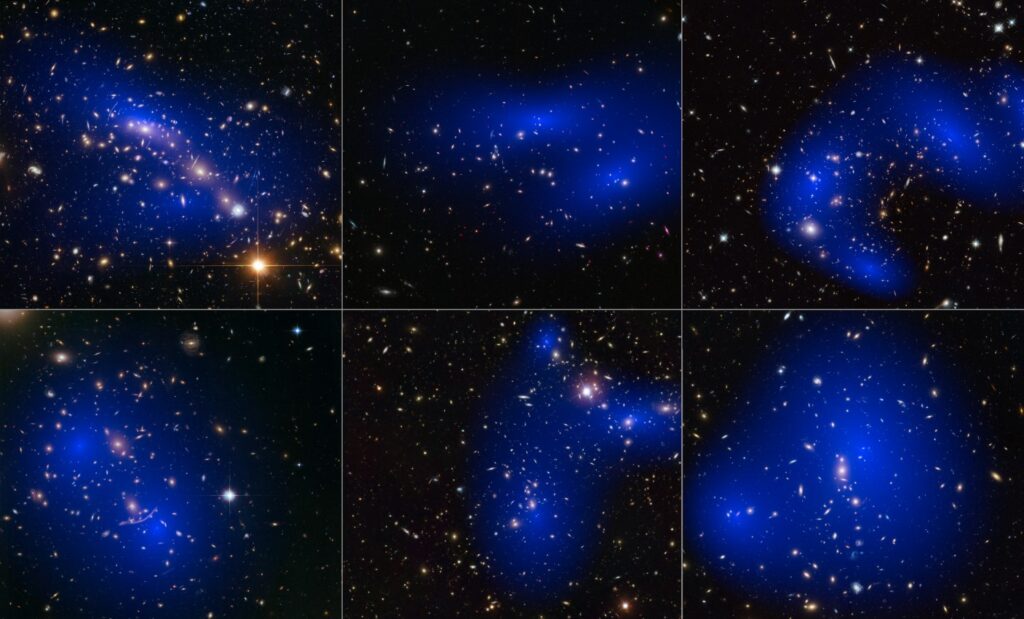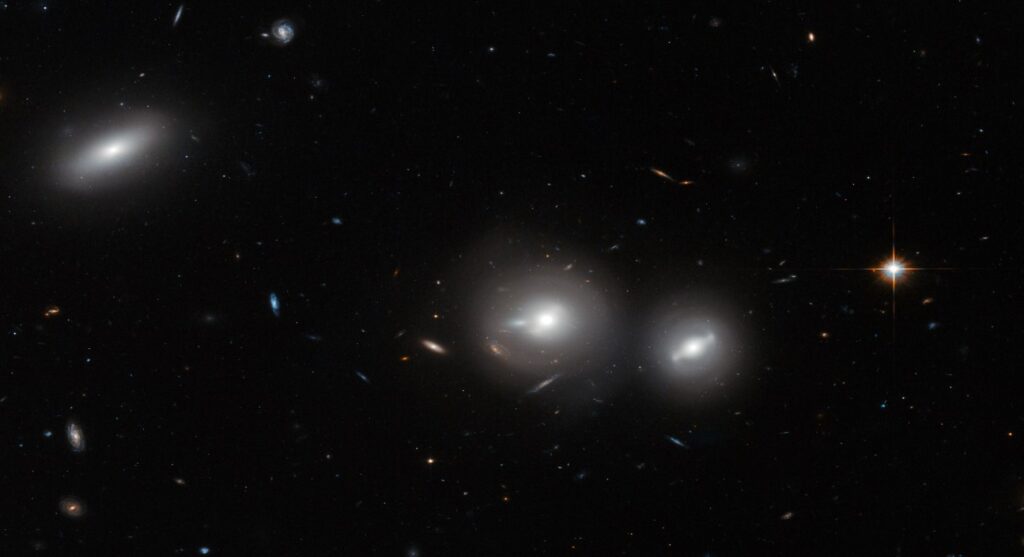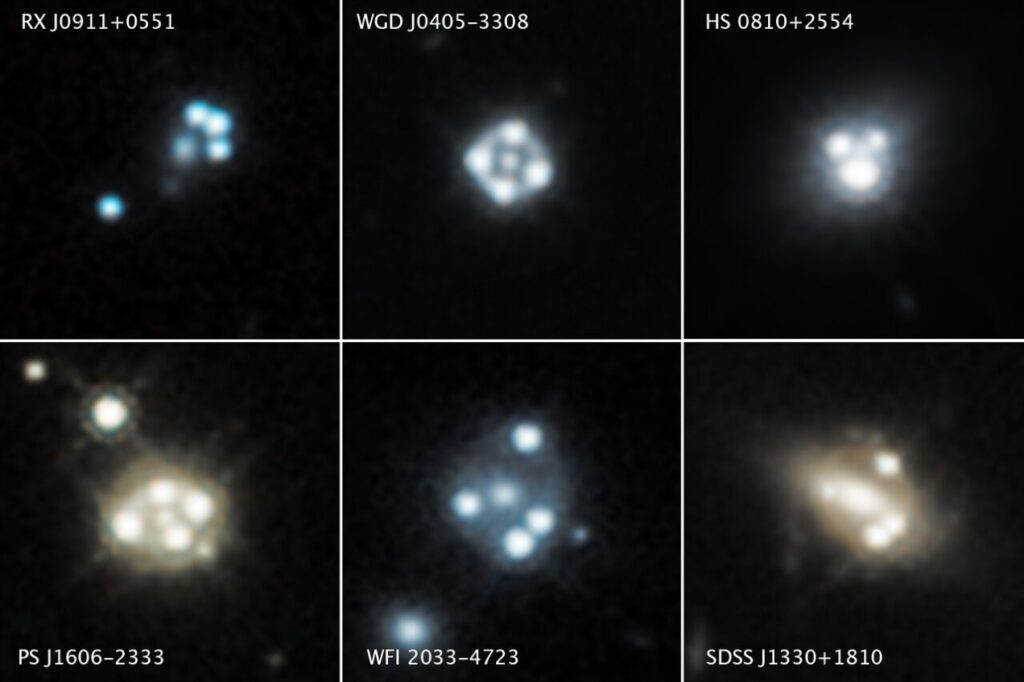We know that galaxies in the Universe are kept together with the help of gravity, but the galaxies rotate at speeds that gravity wouldn’t be able to hold them together and would have torn themselves apart. This also applies to galaxy clusters, which has led scientists to believe that something invisible is keeping these galaxies together. Scientists think that this invisible matter is giving galaxies extra mass which would lead to extra gravity that will help in keeping the galaxy together. This invisible matter is none other than “Dark Matter”. Dark matter is currently one of the biggest mysteries in the universe that scientists have been trying to solve for quite some time.
What is Dark Matter?
Dark Matter is a non-luminous matter which doesn’t absorb, emit and scatter light of any wavelength (so basically its invisible) and does not interact with electromagnetic force. It also interacts primarily via the gravity with visible matter like stars, planets, etc.

The matter we see around us like planets, stars, etc. makes up only 5% of the Universe, while dark matter makes up 27% of the Universe and the remaining by another mysterious substance called Dark Energy. The only things related to dark matter is that it’s invisible, exerts a gravitational pull that helps bind together galaxies and distorts the appearance of space.
When did we come to know the Existence of Dark Matter?
The existence of dark matter was discovered in 1937 by Swiss-American Astrophysicist Fritz Zwicky, who taught at the California Institute of Technology. He studied the movement of individual galaxies within the Coma Cluster which is an isolated and richly populated ensemble of over 1000 galaxies about 330 million light years from Earth and located in the constellation of Coma Berenices. He noticed the huge scatter in the apparent velocities of 8 galaxies with differences more than 2000 km/s. Zwicky applied the virial theorem to the cluster in order to estimate it’s mass.

The Virial Theorem is given by
Zwicky estimated the total mass of the Coma Cluster to be the product of the no. of observed galaxies as 800 and the average mass of a galaxy to be 1 billion solar masses. He then took an estimate for the physical size of the system, which he had taken to be about 1 million light-years, in order to determine the potential energy of the system. From there, he calculated the average kinetic energy and velocity dispersion.
He found out that the velocity dispersion for the 800 galaxies with 1 billion solar masses in a sphere of 1 million light-years is 80 km/s. In reality, the observed average velocity dispersion along the line-of-sight was approximately 1000 km/s. Zwicky also inferred an enormous mass for the Coma Cluster since larger gravitational forces induce higher velocities in the objects they attract. He concluded that:
“If this would be confirmed, we would get the surprising result that dark matter is present in much greater amounts than luminous matter.”
And even though the Coma Cluster ranks among the largest and most massive clusters in the universe, it does not contain enough visible galaxies to account for the observed speeds Zwicky measured.
The observations seen by Fritz Zwicky was later confirmed in the late 1970s by American astronomer Vera Rubin who was studying the galactic rotation curve of the Andromeda Galaxy, galactic rotation curve is a plot between the orbital speed of the visible stars or gases in the galaxy and their radial distance from the galaxy’s center. She observed that the stuff at the edges of the Andromeda Galaxy was moving as fast as the stuff moving near the center, which basically violates Newton’s Laws of Motion. It took two years for Rubin to get an explanation for this strange behavior which now holds as the first known evidence of dark matter.
Candidates for Dark Matter
1. Neutrinos
At first, Neutrinos were considered the perfect candidates for dark matter as they barely interact with matter and they don’t absorb or emit light which means that they won’t be able to be detected by telescopes. They also interact with weak force. And unlike other particles, neutrinos are stable, long lived and don’t experience electromagnetic or strong interactions.It is also possible that neutrinos have a non-zero mass, unlike photons which are mass-less. If they are to have the right value of mass based on the total number of neutrinos (and anti-neutrinos) that exist, then it is possible that they could account for 100% of dark matter.
2. Supersymmetry
Supersymmetry is an unproven yet true relationship between two basic classes of elementary classes: Bosons and Fermions. Supersymmetry requires that for every Boson, a Fermion must exist for the same quantum number and vice-versa. It therefore predicts the existence of several new non-strongly interacting and electrically neutral particles which include the super partners of Neutrinos, Photon, Higgs Boson, Z Boson and Graviton. If these super partners were stable then could be cosmologically abundant and help us get a better understanding of the evolution and history of the Universe.
3. Axions
Axion is a hypothetical elementary particle and a candidate for cold dark matter (will talk about it later in the article). It satisfies the two necessary conditions for cold dark matter:
- Non-relativistic population of axions could be present in the universe in quantities sufficient to provide the require energy density for dark matter.
- They have only significant long-range interactions which is gravitational
4. Weakly Interacting Massive Particles (WIMPS)
Weakly Interacting Massive Particles (WIMPS) are new hypothetical particles which are said to interact through gravity and other forces. It is also as weak as or weaker than the weak nuclear forces and is non-vanishing in strength. Even though the particle is hypothetical in nature, it is believed that it would resolve a number of cosmological and astrophysical problems related to dark matter.
Classification of Dark Matter
1. Cold Dark Matter (CDM)
Cold Dark Matter is a type of dark matter that moves slowly as compared to the speed of light. It is said to have been present in the universe since the very beginning and has most likely influenced the growth and evolutions of galaxies as well as the formation of first stars. It is said to have the following properties:
- Lacks the interaction with electromagnetic force. This is quite obvious as dark matter is dark. Therefore it doesn’t interact with, radiate or reflect any type of energy in the electromagnetic spectrum.
- It interacts with gravitational fields. There has been proof of this as astronomers have noticed that dark matter accumulation in the galaxy cluster has a gravitational influence on light from more distant objects that are passing by. This is called gravitational lensing.

The CDM is said to be composed of Axions and thermally produced WIMPs.
2. Hot Dark Matter (HDM)
Hot Dark Matter is a type of dark matter that moves at ultra-relativistic speed when compared to the speed of light. The distribution of HDM could help us understand the formation of clusters and superclusters after the Big Bang. The HDM is said to be composed of Neutrinos.
3. Warm Dark Matter (WDM)
Warm Dark Matter is a type of dark matter that has properties intermediate between CDM and HDM. The most common WDM candidates are neutrinos and gravitons. The non-thermally produced WIMPs can also be considered as a candidate for WDM.
Proof of Dark Matter
1. Gravitational Lensing
A gravitational lensing occurs when a gravitational field is created by a large amount of matter, like a galaxy cluster, that distorts and magnifies the light coming from distant galaxies that are behind the cluster but are in the same line of sight.

By measuring the distortion geometry, the mass of the cluster can be obtained. In cases that were observed, it was seen that the mass-light ratio obtained corresponded to the measurement of dark matter in clusters.
2. Galaxy Rotation Curves
The arms of a spiral galaxy rotate around its galactic center. The luminous mass density of a spiral galaxy decreases as we go from the center to the ends. From Kepler’s Second Law, it is expected that the rotational velocities will decrease as we move away from the center similar to the Solar System, but instead the galaxy rotation curve remains flat or constant as we move away from the center.

If Kepler’s laws are correct, then the only way to solve this problem is to conclude that the distribution of mass in spiral galaxies are not similar to the Solar System. Which means that there is a large amount of non-luminous matter/dark matter at the ends of the galaxy.
3. Galaxy Cluster
Galaxy clusters help in finding the existence of dark matter since their masses can be calculated in three different ways:
- Scatter of radial velocities of the galaxies in the cluster.
- Gravitational lensing
- Galaxy clusters shine at X-ray wavelengths as they are filed with hot gases. Scientists use this X-ray data to find the measured properties of the gas so that they infer the mass of the galaxy cluster.
- Sunyaev-Zel’dovich Effect: It is the shift in the wavelength of the Cosmic Microwave Background which is the light or electromagnetic radiation left over from the Big Bang. The shift occurs when the light passes through hot gas in the cluster. The size of the shift in the wavelength helps us determine the mass of the galaxy cluster it has passed through.
The Search Continues
Many Organizations are now performing experiments to identify the possible dark matter candidates. Some of the experiments are:
- Beneath the Gran Sasso Mountain in Italy, the Laboratori Nazionali del Gran Sasso (LNGS) XENON1T is searching for interactions when WIMPs collide with Xenon atoms.
- IceCube Neutrino Observatory, Antarctica has an experiment underneath its ice that is searching for sterile neutrinos. As they only interact with normal matter through gravity

- The European Organization for Nuclear Research (CERN) lab, Switzerland is also searching for dark matter by interacting its candidate particle with antimatter through the Large Hadron Collider (LHC).





[…] so far. There are a few things the equation does not contain any information about. : Inflation, Dark matter, Dark energy and so […]
[…] they could harbor life. Under this field, they have a no. of researches like Physics of the Cosmos, Dark Matter & Dark Energy and Black Holes to name a few. The Hubble Space Telescope has been getting images […]